Fifty five years later, how we remember the 1965 Immigration and Nationality Act directly correlates to the strength of our solidarity movements.
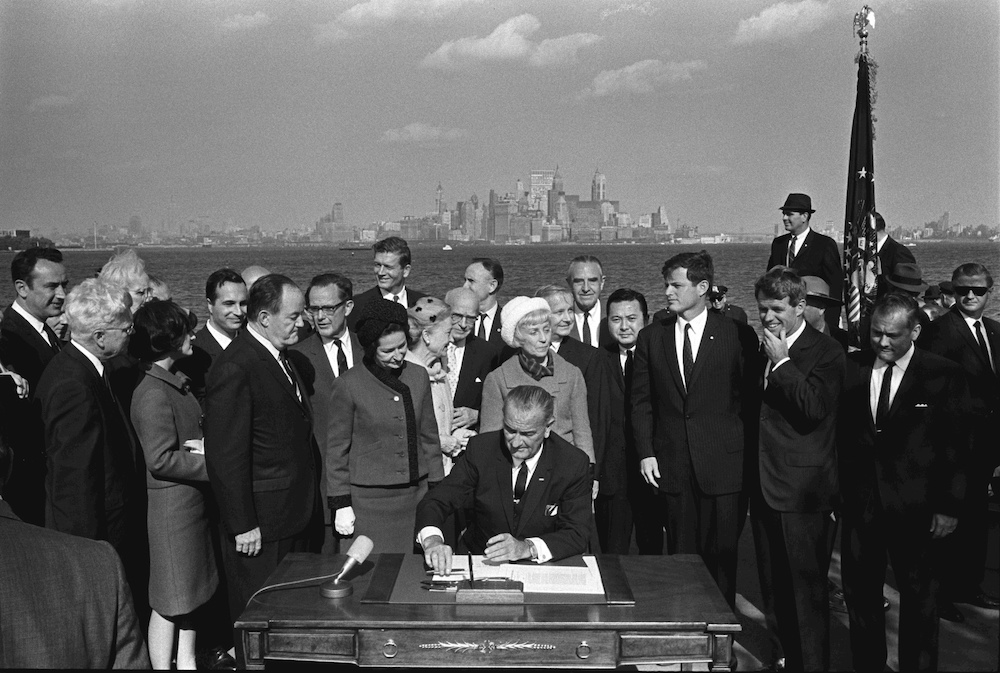
October 2, 2020
When my family set foot in the United States, they arrived in a chain. I’m not talking about interlocking ringlets of steel, hugging the wrists until blood swells, used to arrest, detain, and restrict movement. I’m talking about a human chain forged together by blood and the bond of marriage. My mother’s eldest brother, with his wife, arrived first in San Francisco. During the incipient stages of the Cultural Revolution in 1967, they joined the ranks of those who attempted the treacherous four-kilometer swim across the Shenzhen Bay from Guangzhou to Hong Kong at the risk of their lives. Those who took the plunge knew the possible fates that awaited them. They could either become another lifeless émigré body shot up by the People’s Liberation Army or be corralled by British border patrolmen after suffering scores of oyster bed lacerations. My uncle and his wife touched shore successfully and eventually filed for refugee status. Soon after, they arrived in the United States in 1973.
Where once my uncle feared for his family’s safety back home, the United States presented a new challenge. The continuation of this protracted human chain depended on my family’s comprehension of the three-tiered quota system of U.S. immigration—family or employment, visa types, and per country limitations—and our fastidious record-keeping of each waiting line per visa.
Since sibling sponsorship is only granted upon citizenship, my uncle would not sponsor my mother’s passage to the U.S. until 1980. My mother waited nine years, just in time to have married my father, before they arrived in San Francisco together in January 1989. Five years later, they also pledged allegiance before the flag in the Land of Lincoln, where we would eventually relocate. My father sponsored his mother immediately, and because the sponsorship of a parent was significantly shorter than that of children and siblings, she waited a meager year before arriving. Eventually, my paternal uncle and his family would also arrive on a staggered timeline in cases that may or may not have involved legal discrepancies. But that is a story for another time. This chain began in the 1970s and ended in 2012 with the longest individual wait stretching for twelve years.
I grew up watching shaky camcorder videos of my family’s first years in America. I was the round Buddha baby who played the protagonist in many of these grainy recordings where my older brother incepted the scenes—often as an antihero. My mother usually smiled at the camera while positioning me in different zones of the safari of the Golden Gate City, waiting for something phenomenal to happen. I could be tumbling in the courtyard with the concerted valentine blooms of the Conservatory of Flowers or striking a pose with the inimitable Painted Ladies below a fire-breathed sky. My father was the invisible omnipresent narrator who offered action-packed commentary in a digitally muffled voice. I saw that we were happy, maybe even grateful, despite being cramped with my aunt’s family in their basement domicile in classic SRO fashion. I knew that I was a child of immigrants.
Children like me were everywhere in Chicago’s Chinatown. Many of the parents of my friends worked in restaurants that lined Wentworth and Cermak. Some worked in bakeries. Few held high-skilled jobs like doctors or engineers, but those who did used their Chinese fluency to serve our immigrant community. Social mobility in this country was (and is) an impossible dream for those without some degree of English fluency. Many, like my parents, combined ambition and business savvy to pursue the tried and tested formula of operating their own Chinese restaurant, demanding long days and long nights. In their absence, I found a safe harbor in the immigrant church located at the heart of Chinatown. Countless threads of human chains reticulated into this enclave to survive me and many others.
Immigration was the lifeblood that satiated bellies. It constructed houses of worship that nourished spirits. It built thoroughfares like Wentworth and Cermak that established flourishing communities for those looking for a dock in which to anchor; a dock where I was squarely situated.
Our passage was paved 55 years ago this week by the 1965 Immigration Act, also known as the Hart-Celler Act. It is seen as one of many victories that resulted from a civil rights movement initiated when Brown v. Board 1954 created precedent for desegregation. Largely overshadowed by the Civil Rights Act of 1964 and the Voting Rights Act of 1965, this piece of legislation was the monumental shift that forever changed the ethnic and racial makeup of America. Tom Gjelten in A Nation of Nations said the bill demonstrated that “the United States unconditionally embraced its immigrant character.”1 According to Pew Research Study, 84 percent of the U.S. consisted of non-Hispanic whites before 1965 compared to 62 percent of the same in 2015. It was especially rectifying for the Asian American community who were serially barred from entry since as early as 1875. Following 1965, Asians, who made up 1 percent (1.54 mil2) of the U.S. population at the time, doubled almost every decade.
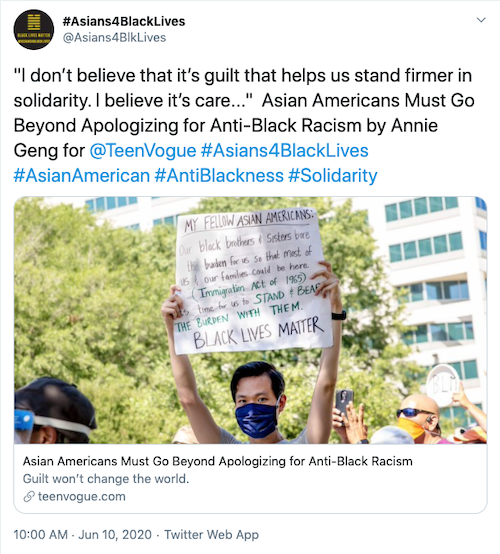
How we remember the 1965 Immigration Act directly correlates to the strength of our solidarity movements now. In a photograph published alongside a Teen Vogue article from this June, an Asian protestor is shown holding a sign that reads: “My Fellow Asian Americans: Our black brothers & sisters bore the burden for us so that most of us & and our families could be here. (Immigration Act of 1965) It’s time for us to stand & bear the burden for them. Black Lives Matter.” The 1965 law is used as a point of reference to galvanize Asian American movements, but when framing this historical juncture, many Asian Americans fall back on permutations of indebtedness—“we owe it to Black folks because..”—to justify our participation. But is this paradigm contradictory to our efforts for solidarity? A closer examination of this piece of legislation shows us that the transactional aspects of this law have been conflated into a narrative of liberation. This conflation, particularly for those grasping for a historical entry point that connects them to liberation, blinds us to the harm it has caused and how the law is largely culpable for how “illegality” is conceived of today. The way we recollect and make meaning of the 1965 Immigration Act has focused so heavily on the liberation of Asians from decades of exclusion that it renders invisible the furtive transferral of illegality to Mexican Americans. Whereas Mexican migrants were relatively free to move before 1965, the caps implemented by this law—limitations that were grossly incommensurate to the flow of immigration at that time—changed that.
Human migration and conceptions of illegality are intimately entangled in this country, regardless of what any migrant has done. In 2018, a report released by the National Immigrant Justice Center shows that approximately 75 percent of those detained by ICE either posed no threat or had committed minor infractions. This could mean being penalized for littering or jaywalking, the middle school equivalent of getting caught throwing a paper ball. In Berkeley, California, an undocumented migrant is one whistle for a lost canary away from being declared “illegal.” In New York State, they are one pair of yoga pants worn in public away from the same. These inconsequential acts are the difference between freedom and detention; legality and illegality. Statistics collected by Freedom for Immigrants uncover the harsh conditions detained migrants are subjected to once the status of illegality has been cast on them. The plethora of immigrant rights violations range from medical inaccessibility to sexual abuse. Despite insurmountable evidence of inhumanity, more money continues to be poured into funding immigrant criminalization.3
The 2016 election, and the xenophobia trickling from individual campaigns leading up to the election, awakened me to the complications of human migration. Donald Trump ran for presidency underneath a banner of both implicit and explicit demonization of immigrants, electrifying a voter base with provocative promises to build a wall at the southern border and to impose a Muslim ban. He signed three draconian executive orders immediately upon entering office to enact these promises. The results included the barring of migrants from predominantly Muslim nations, the separation of families, the detention of thousands in unsanitary conditions, and the funneling of children into government custody.

Whitney Hu, an organizer for Sunset Park ICE Watch and candidate for City Council District 38 in New York City, says that though people across migrant communities are being deported, this dragnet discriminately targets some more than others. “ICE itself under the Trump administration has been radicalized to only search for those who are seemingly Latinx,” says Hu. The numbers corroborate this assertion. A report released by the U.S. Government Accountability Office showed that in 2018, Mexican immigrants were being deported at rates incomparable to any other national demographic at 139,330 people. The report also showed that the top nine groups with the highest deportation numbers were located south of the U.S. border.4
The presidential records prior to Trump’s induction show the reality that criminalizing immigration is not a new agenda. Immigration activists commonly refer to Barack Obama by the scathing moniker “deporter-in-chief” due to the ostensibly reported apex of deportation numbers between 2012-2014, but a closer look shows that both the Clinton and Bush administrations recorded numbers far higher when both “returns” and “removals” are taken into consideration.
The Asian American and Mexican American immigration stories may seem disconnected, but history tells us otherwise. The myopic consciousness that separates the two is largely due to how the 1965 Immigration Act has been narrativized, especially to the Asian American community. Though this law impacted these two demographics most starkly, it also changed migration patterns for those from Africa, the Caribbean, and Latin America.5
But we are not only connected by the nexus of 1965. Many Asian migrants have come to the United States by way of chain migration. This does not exactly mean they are allowed to come on their own terms, but they are granted freedom from a criminalized status; one that jails the migrant in the American imagination before there is any cause for bondage. Mexican migrants do not have the same luxury. Our system has been built to occlude them from entry and to threaten them by the chains of incarceration long before they make their trek north. The shadow of this bondage looms large in their imagination. So whether forged by blood or by steel, my family and migrants coming from the southern border have both become acquainted with migration through chains. These chains, though different, unite us more than separate us. Both determined by the same historical juncture. Both negotiated by a similar set of principles. And both arbitrated by a system that criminalizes movement.

For Asian Americans, the 1965 Immigration Act is signed as a denouement to a system of legalized exclusion that begins with the genesis of the concept of the illegal immigrant. Dreams of 金山 (gold mountain) pulled Chinese laborers to the novel American West in the early 1800s. Not soon after, state laws were imposed that excluded Chinese immigrants6 from the public school system, from voting, and from testifying in any court case that included a white person. California, at one point, even passed a state law that barred Chinese and Mongolian entry in 1858 before it was struck down by the Supreme Court in 1862. White Americans charged with anti-Chinese sentiment, particularly in California, perceived Chinese immigrants as a threat to the nation’s gender and family values and launched concomitant tirades on their “paganism.” During the economic decline in the 1870s, politicians like San Francisco mayor Andrew Jackson Bryant and California governor William Irwin drew on a movement of nativist hostility—most previously wielded by the Know Nothing Party against Irish Catholic immigrants—to focus on “the Chinese Question.”7 This cauldron of racialized fear and hatred spilled eastward to create precedent for federally mandated restrictions.
Since Chinese men came to the United States as a source of cheap labor, sojourning across the Pacific with their families was not financially feasible; as such, the initial wave of Chinese migrants was overwhelmingly male. Similar pathways for conventional labor opportunities were not offered to Chinese women in this bachelor society and as a result, women determined to immigrate deferred to sex work as their only option. It was through this gendered stricture that the Page Act of 1875 was passed as the first regulatory immigration law. This law was written under the guise of restricting contract laborers, felons, and prostitutes, but aimed specifically at targeting women from “China, Japan,” and any “Oriental country.”8
Sinophobia spread so rabidly that by the time the Chinese Exclusion Act of 1882 was introduced by Senator John F. Miller of California, its approval seemed inevitable. The passing of this act made it the first explicitly discriminatory immigration law that aimed to bar entry of a specific group of persons. The recession that followed was the match that lit an already incendiary sociopolitical climate. All hell broke loose. “The Chinese Must Go” became a vigilante war cry that preceded mass expulsions and massacres of Chinese residents in cities across California, Washington, and Wyoming in 1885 alone. The Geary Act of 1892 renewed the exclusion law with further restrictions before it was reified as the law of the land by 1904.9
Sinophobia would evolve to encompass anti-Japanese, and eventually anti-Asian, sentiment as ideas of the “yellow peril” were globalized during the early 20th century. Nations of the white western world built a perception of one [non-white] race threatening the extinction of their society by world domination. Little did they know that the discrimination of one race would eventually catalyze an upending war by Nazi Germany three decades later. Agitprop texts such as The Valor of Ignorance: The Inevitable Japanese-American War (1909) by military strategist Homer Lea and The Rising Tide of Color Against White World Supremacy (1920) by historian Lothrop Stoddard circulated to drive mass hysteria. The populist campaign of James Phelan, singularly charged with nativist ideology, complemented these texts to ignite sparks of state-legislated alien land laws. The 1924 Immigration Act ensued to create another blatantly exclusive quota system by assigning a quota for all Western Hemisphere immigrants except those from Asia—officially augmenting the demographics of the exclusionary clauses to include Japanese and Indian migrants.
At the time, since the Philippines was occupied as U.S. territory, Filipinos were subject to the same anti-Asian attacks, but were not included into the superimposed illegalization of the quota system. The Tydings-McDuffie Act of 1934 changed that when it gave independence10 back to the Philippines and gradually folded them into the exclusionary quotas. The Filipino Repatriation Act was signed in 1935 to ship Filipino residents back to the Philippines.
Once the theories of eugenics exploded into a cataclysmic war, the U.S. decided that its racialized immigration codes might signify residue of the ideas that produced the Holocaust. The Chinese exclusion law was repealed in 194311 and a racialized quota system was finally eradicated in 1952.12
One of the earliest sites of immigrant exclusion also happens to be a site of detention and therefore illegalization. The first of these was a two-story, one-hundred-foot building leased to the U.S. government by the Pacific Mail Steamship Company.13 The privatized prison model characterized by unsanitary conditions in a dilapidated shed draws uncanny parallels to the detention apparatus today. After public outcry to these conditions, Angel Island emerged as an immigration station and de facto detention center that was commonly referred to as the “Ellis Island of the West.” Although it served as a conduit for migrants coming from over 82 countries, about 70 percent of those filtering through were Chinese.14 They were also the primary detainees subject to intensive interrogation sessions, humiliating medical examinations, indefinite holdings, and potential deportation.15 Migrants entering through this port remained in detention for an average of two weeks but many were detained from six months to a year. The longest recorded stay was Kong Din Quong who was detained for 756 days.16
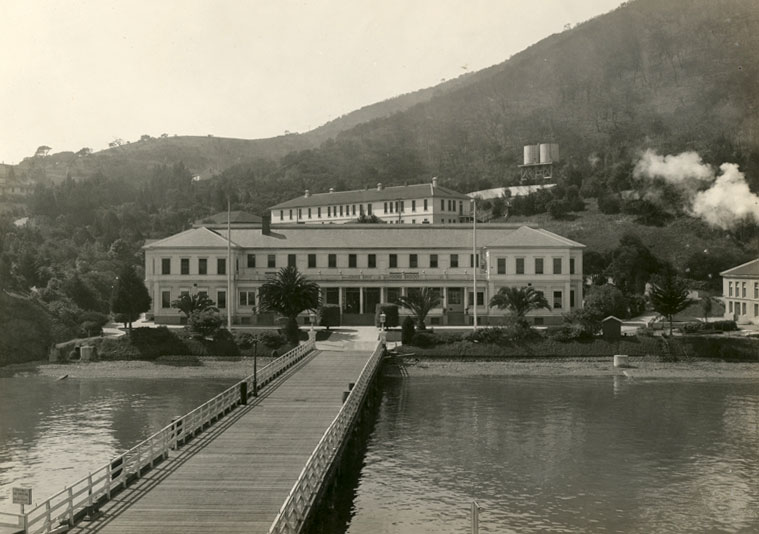
The prison as a site of warehousing and criminalization connects Angel Island to Japanese Incarceration. At first glance, incarceration camps like Tule Lake, Manzanar, Topaz, and others seem to begin where Angel Island ends, but the archives reveal that Angel Island in fact served as the original site of WWII incarceration for political prisoners. This experimental political prison, masked as an immigration station, followed the same blueprint established during the years of WWI. The war turned the displacement of the Japanese in the entire Eastern Hemisphere and concomitant incarceration into a public spectacle. Many were forced from their homes, deported from their countries to the United States as political prisoners, and even had the citizenships from those original countries renounced. Multitudes of Japanese officially became nationless exiles. The lines between exclusion, incarceration, and migration were blurred into one for the Asian American. When the same tactics deployed for war are used to incarcerate at ports of entry, movement itself becomes a site of warfare.
No law can erase decades of anti-Asian sentiment cultivated during the era of exclusion, but the 1965 Immigration and Naturalization Law bookended an era of legalized exclusion of Asians by the hands of the state. Asian migrants, many of whom coming from embattled nations tormented by political tumult, rushed to the gates to become early claimants of citizenship; all the while blinded by the transactional clause slipped into the bill that exchanged the relative freedom of Mexican migrants with the status of “illegality.”
“We didn’t cross the border, the border crossed us,” is a rallying cry of the Mexican American community that echoes the origin of the modern day US-Mexico border. With the Texas Annexation of 1845, the Treaty of Hidalgo of 1848 after the Mexican-American War, and the Gadsden Purchase of 1853, the border expanded to encompass much of what we know now to be the American West. In less than a decade, large swathes of Mexican residential land, what amounted to about half of Mexico, was subsumed into the U.S. and approximately one hundred thousand Mexicans residing on the annexed land were promised “all the rights of citizens of the United States.”
When the Office of the Superintendent of Immigration was established in 1891, the status of illegality was not so inextricably coupled with Mexican Americans as is done today. This office became the Bureau of Immigration in 1894 and fell under the umbrella of the Department of Labor (DOL)17 in 1904. This would again be renamed to the Immigration and Naturalization Service (INS) in 1933, the behemoth that was split and reassembled into our modern-day triumvirate.
The structuring of this bureau under the DOL indicates that their function was twofold: regulating entry for some and labor for others. This sorting was largely tied to race. Mexicans were not only allowed entry but enthusiastically encouraged to come and fill the cornucopia of labor vacancies during the rapid industrial growth of the early twentieth century. This is reflected in the vetting process of the 1917 Immigration Act. The literacy test and hefty head tax would have been an impervious obstruction for Mexican migrants, but since it was partial to barring Asians and European socialists, Mexicans were often selectively overlooked.18 A half million Mexican workers entered the U.S. between 1900 and 1930 with a total population of two million by 1928.19
A triangulated relationship existed between migration, legality, and labor. To create a bureau for immigration enforcement meant that the U.S. intended to set a precedent for controlling movement for the very first time. Migration could only be legal after set conditions were met. What reconciled migration and legality was the condition of labor, specifically whether or not the labor met a production need. New industries of mining and agriculture in the Southwest states demanded an influx of laborers and since Mexicans were the previous custodians of the land, they also became an attractive source of labor. The footnote to the regulatory shape this model took was that the migrant labor being received must not threaten the economic stability of white Americans.
If this triangulation was not apparent enough at the birth of the INS, the Great Depression crystallizes this quid pro quo in the vicissitudes of early 20th century Mexican migration. White laborers decried Mexican migrants for taking away jobs in the sudden scarcity of work amidst a declining economy. Unemployment climbed from 4.3 million people in 1930 to 15 million people in 1933, or a third of the American population.20 The legality of Mexican migration disintegrates once their labor threatens the white supremacy upheld by the nation’s economic system. States like Colorado and Arizona rushed to pass laws to curtail Mexican labor opportunities and the federal government introduced the Works Progress Administration (WPA) as part of the New Deal to reboot the economy with publicly funded jobs.21
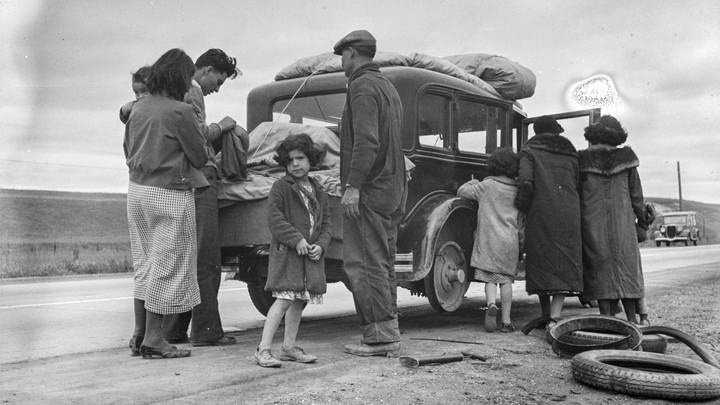
With Mexican laborers being excised en masse from the workforce, their communities under siege by violent nativists, and the perennially unprotected status of the non-citizen, these migrants were set up for the largest deportation of U.S. history, the Mexican Repatriation. Former California state senator, Joseph Dunn, calculates that close to 60 percent of those deported were actually citizens to make this not only the largest mass deportation but the largest illegal deportation. Before Mexican and Filipino farm workers were united by the Delano Grape Strike in 1965, they were connected first by repatriation during economic decline. The illegality of migration is exposed as a deus ex machina subjected to capitalist demands, easily wafted away when it proves to be an inconvenience. And in the same way, the mirage of illegality can be easily rewritten, redesigned, redeployed, or transferred as we will see in 1965.
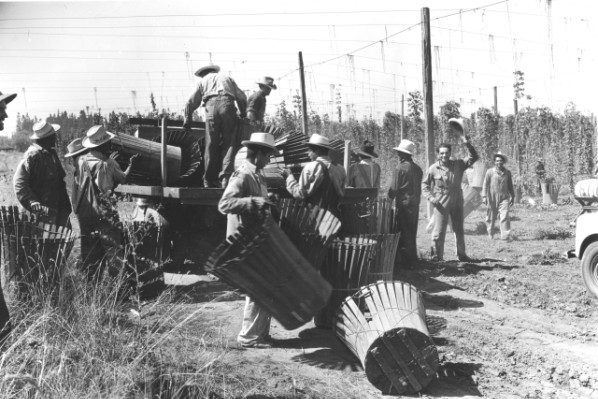
No one could have predicted that the world would break out into a second world war when the country would once again see a massive labor shortage. The U.S. and Mexico initiated the Bracero Program in 1942 to once again bring Mexican guest-workers to fill the void. The three-pronged pitchfork of the DOL, INS—now under the Department of Justice (DOJ)—and American employers promised fair living conditions but instead treated the migrants like farm animals and completely disenfranchised them.22 The examination of this program and other patterns of Mexican migration in the U.S. demonstrates not only the tenuousness of legality for migrants but also the tenuousness of justice as defined by legality, denoted by the restructuring of the INS from the DOL to the DOJ in 1940. The program extended through the Korean War and ended in 1964, legally bringing 200,000 braceros each year or what amounted to over 4.5 million people. In addition to this program, 35,000 people were admitted for permanent residency each year.23
Months before the 1965 Immigration Act passed, Ohio senator Michael Feighan brokered a deal with President Johnson to introduce Western Hemisphere caps for the first time. In order to push the bill past the finish line, Johnson conceded. This law is renowned for instituting equal caps across all Eastern Hemisphere countries and for paving the way for migration through family reunification, but it is lesser known for its cap of 120,000 immigrants in the Western Hemisphere that was eventually divided into a per country cap of 20,000 in 1976. In a matter of years, limits were placed to truncate a near infinite number of migrants from Mexico, the Caribbean, and Latin America.24 In attempting to abolish the national origins quota and replace it with a system of equal caps, the law ignored the current flows of migration at the time. The number of Mexican migrants was most severely reduced, from ~235,000 to 20,000 annually, effectively transferring the status of “illegality” from Asian to Mexican migrants while the law was championed as a civil rights victory.25
In shifting a blatantly racialized immigration system to an egalitarian one—marked by hemispheric caps—the notion of illegality was temporarily lifted from Asian Americans, who were forced to renegotiate the legality of their migration with the same triangulation once negotiated by Mexican migrants. The emergence of the model minority myth created the perfect red herring, veiled as cultural discussion, to dignify our existence in the U.S. with the proof of our labor. The legality of Asian migration also needed to be reconciled by labor.
The influx of Asian migrants did not only change the face of the U.S., but also that of Asian America. While familiar Asian subgroups benefited from the family reunification clause of the 1965 law, new Asian migrants26 came as refugees through laws such as the Indochinese Immigration and Refugee Act of 1975. Wars, sanctioned and supplied by the US, relocated migrants from the detritus of their bomb-razed homes in Vietnam, Cambodia, and Laos to the strange new land of America. The Asian migrants’ need for government assistance sounded alarmists who stipulated that Asians were taxing social services and becoming a burden to the economy. Other reports rebutted that Asians were creating jobs, generating wealth, boosting the economy; even possessed a near supernatural work ethic that would identify them as a model minority. Possessing an innately exceptional labor quality is rehearsed rhetoric used in the same way to justify the substantial intake of Mexican farm workers in the past.27 Auteur Frank Chin called this kind of pawning “racist love.”
For a long time, the model minority myth was buttressed by attendant ideas such as tiger parenting and the bamboo ceiling, but it is now recognized as a racial wedge weaponized to prevent Black-Asian solidarity. Even so, old habits die hard. Andrew Yang’s recent Op-ed shows us that ridding the deeply internalized model minority logic of using work to prove worth may be harder than it seems. When the visa status of international students was threatened by the Trump administration recently, the economic measuring stick was brought out to make the same brand of argument28; throngs of Asian Americans echoing the same chorus. Upon proving labor value, the clamor of 17 states and multiple tech firms threatened to sue and the rule was rescinded. A sufficient currency met the conditions for migratory freedom this time.

In the South Asian migrant community, this negotiation is complemented by an abiding casteist structure that fits neatly into both the model minority myth and the structural violence it acquiesces. “Caste is a system of oppression analogous to race but is not the same as race. It is assigned at birth and determines … your position in society,” explains Thenmozhi Soundararajan, director of Equality Labs. She tells me that casteist mindset is reflected in Indian migrants to the U.S. as early as the 1920s in the cases of AK Mozumdar and Bhagat Singh Thind, who attempted to position themselves in closer proximity to power by evincing their Aryan origins and even vowing support for anti-miscegenation laws. Though Indian migrants may hold significant labor currency today, reflective of their overwhelming representation in H-1B visa approvals, a hegemonic modus operandi in a predominantly upper caste migrant community inclines them to align with power. Soundararajan says, “Even with the immigration battles now, we have a group of upper caste Hindus that argue that if they can get expedited greencards out of their H1 categories, they would pay more money and let that money be allotted for Trump’s wall.” This dalliance of casteism with white supremacist meritocracy is also at the bedrock of the model minority myth.
By conceiving of the 1965 Immigration Act as a liberating law, Asian Americans are situated in a transactional paradigm, which is in direct contradiction to solidarity with other immigrant groups. In a politics of transaction, chains are seen in separation. The only way to achieve liberation is to broker a deal to conduct a fair exchange. One set of chains for another set chains. Our inclusion, if only for a very fleeting period of time, in exchange for their illegality. Their freedom in exchange for their labor. But who decides how to measure the value of each exchange? Who decides that bondage should be assumed like a congenital debt unless recompense fulfilled? Who built an arena of competing freedoms so that the liberation from our chains must come at the cost of another’s? In a politics of solidarity, each person’s chains, each person’s bondage, and each person’s freedom is interconnected. It collapses the paternalizing “us-them” paradigm that inexorably reasons or pays or prays for the emergence of the other’s freedom. Their bondage is our’s also. In a politics of solidarity, freedom is no longer based on merit; freedom simply is and should be, for us and for all.
While much of the Asian American community was caught in the maelstrom of the triangulation of migration, legality, and labor, the average waiting line for Mexican immigration rose sharply from 9 months in 1969 to 21 years according to a 2018 report. When we look at admission through family reunification, the primary way Mexican migrants enter the United States, the backlog disparity is unrivaled to any other country, sitting at 33 percent of the total backlog, or ~1.3 million people. The 1965 transfer of illegality provided a short relief for Asian migrants with relatives in America, but that status was quickly recast. When family visas are disaggregated, the backlog for certain visas per Filipino and Chinese migrants are equivalent to those of Mexican migrants.29 While not similarly subject to snaking lines, South and Southeast Asian communities have been severely targeted after the passing of the Illegal Immigration Reform and Immigrant Responsibility Act (IIRIRA) of 199630 and the USA Patriot Act of 2001.31 “In New York City, the most immigration cases tend to be APA32 … but we’re less likely to be deported compared to Latinx, especially those coming from Mexico, Guatemala, or El Salvador,” says Hu. The impermanence of the “freedom” granted to Asian migrants in the 1965 law shows us that the pangs of partial liberation, at the mercies of expiration, will always catch up to us. Liberation for some at the cost of others is not liberation at all.
Once again, I turn my analysis back onto the prison as the site of criminalizing movement. The caveat for incarceration in the era of Asian exclusion was the financial burden it placed on the government to maintain sites of imprisonment. This was a major reason Angel Island and Ellis Island were shut down with little hesitation by the 1950s. The web of the privatized prison model was developed during the Reagan era, eventually stretching to encompass immigration detention. The top five states with the largest number of migrants detained hold over 31,000 people per day, about 70 percent of whom are held in privately run prisons. GEO Group and Corrections Corporation of America (CCA)33, the two largest contractors, received $184 million and $135 million from the U.S. government in 2017. The criminalization of movement today flourishes by the inversion of the triangulation model. Whereas before, migrant labor value justified the legality of migration, we now see the U.S. government’s dependence on migrant illegality in order to create labor opportunities for others, inflate the capital of those monopolizing the prison industry, while still wringing out $1 per day of cheap labor from migrants in detention.34
How the movement of both Asian and Mexican migrants have been wrapped up in the same process of illegalization—exacted with the same principles of negotiation, and subjected to the same economic whims—demonstrates that we cannot be free until all are free. “If we are [to] collectively achieve liberation and freedom for ALL oppressed people we need to organize from the bottom up–organize to support and free the most marginalized in our communities,” says Nate Tan, a co-director at Asian Prisoners Support Committee (APSC) in Oakland, California. APSC provides direct support to Asian and Pacific Islanders (API) caught by the snare of the prison system, but is not a lone actor. They operate in a wider coalition of Asian activist groups organizing against API immigrant incarceration and deportation called the 510 Action that also includes the Center for Empowering Refugees and Immigrants. Asian American activists like Tan concentrate their efforts in coalition building as the site of freedom against the oppressive immigration system.
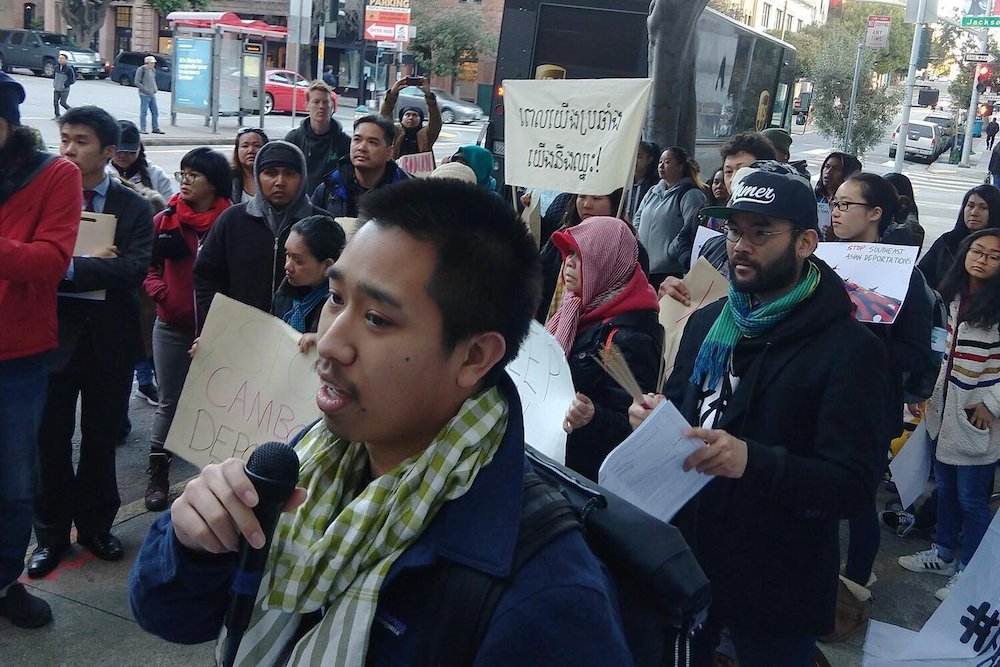
Asians 4 Black Lives (A4BL), an affinity group that operates similarly to a coalition, is also engaged in active resistance against immigration detention, mass incarceration, and police brutality. Claudia Leung, an organizer for A4BL, says that members in their network participate in a range of activism that includes “climate justice, trans and queer liberation, immigrant and refugee rights, prison abolition, movement defense, transformative justice, anti-imperialism, [and] housing justice.” An A4BL comrade of Leung’s, Sarah Lee, explains that “low-income, immigrant, and refugees [in] API communities, particularly Southeast Asian and Pacific Islanders … resettled in cities where Black communities have already been systematically deprived of decent housing, a living wage, [and] access to healthcare.” Living conditions that include over-policing and a deprivation of social services, education, and health care ravages the communities that house both Black folks and Asian immigrants demonstrating that their experiences of systemic oppression are inextricable from one another. A4BL sees immigration as a personal issue in which members of their community are affected, but does not detach it from the larger systems of oppression.35 Leung calls this coalition their “political home” in which they have been able to develop deep intersectional analysis on where APIs fit in the culling process of ICE.
Out of their political reflection, A4BL has conducted direct nonviolent action since its emergence from the Ferguson protests in 2014. Leung recounts A4BL’s most recent action in Sacramento in July when they were arrested. A couple of A4BL members joined by a group of immigrant lawyers and undocumented activists chained themselves to the gate of Governor Gavin Newsom’s California mansion to demand that he free the imprisoned from both ICE detention and state prison amidst COVID-19 outbreaks. Not long after this demonstration, it was reported that at least 17,600 inmates may have been released early. “[It] feels like a significant, although incomplete, victory,” she says.

As part of the Sunset Park ICE Watch in Brooklyn, NY, Hu also frequently organizes with local entities such as the New Immigrant Coalition, Good Shepherd Church, and the Chinese American Planning Council (CAPC). She recalls an instance with a pregnant mother whose undocumented husband was picked up from his worksite by ICE. He was previously given a deportation notice before this arrest so advocating for the case was difficult to justify, but they refused to give up. “Jorge (another organizer) and I were the ones at the hospital when she gave birth and not her husband,” says Hu. “At that moment, I realized that we don’t belong here. I was so angry.” As a result of movement criminalization, ICE has ruthlessly ripped families apart. Mobilizing against ICE doesn’t always look like unified shouts of pithy declarations or distributing Know Your Rights flyers. It is shaped by the needs of migrant neighbors. “If I have neighbors who are under attack and my community is facing hardship, that’s what I’ll focus my time on,” says Hu. The new family of three was eventually reunited after legal representation was found.
Many of these organizers have found their way to Asian American coalitions after sleuthing through the historical archives to compile a longer, more radicalized, more disaggregated history of Asian America, often untaught by schools unless ethnic studies is offered, to map themselves in the larger topography of American immigration. Building solidarity for some means seeing the throughline that strikes right from the era of Asian exclusion to the illegalization of Latinx coming from the southern border. For Tan, it means defending Southeast Asian migrants in his own community who are deliberately and aggressively targeted by ICE. Kristina Tendilla, Executive Director at Alliance of Filipinos for Immigrant Rights and Empowerment (AFIRE) in Chicago, said that many of the participants in their coalition were heavily politicized during the time of martial law in the Philippines so their solidarity is largely informed by a transnational consciousness shaped by oppression witnessed beyond our borders. And although Equality Labs does not mobilize against ICE directly, Soundararajan organizes transnationally to address casteism across the South Asian diaspora in order to divorce them from imperial allegiances.
These coalitions do not only exist to coordinate local actions, but also serve as an incubator where harmful paradigms are unlearned and a new ethic of solidarity built with an ethos not unlike kindred love. Those who participate in these coalitions often share common histories with one another and inform their ethic by these distinct reference points. Here is where self-actualization, analysis, and collective mobilization converge, making it fertile ground as sites of praxis.
There are some things we know before much learning is done at all. When I roll the tapes of VHS memories circa 1992 listening to my mother’s playful harangue and my father’s high-pitched laugh, a laugh I inherited, while they watch me slam blueberries into my cherubic cheeks, I hear freedom in their voices. My parents were not heroes. They were normal people living simple lives. But for a long time, they were the protagonists of my story. Once I entered the classroom, history was lined with white military generals, white authors, white scientists. Victors. Inventors. Creatives. My story subsumed into another story. My parents now lost into the abyss of my story.
History too, is bound by a chain. Restricted by dominant tellings of those in power that imprison those who dare to challenge it. Records of violence are neatly erased and legality rewritten to serve this telling. Moments like the Civil Rights Movement and the 1965 Immigration Act are co-opted to commemorate this nation as the land of the free, venerating those with governing power as lovers of liberty. But the idea of freedom in America has always been near-sighted. Soldiers die for freedom abroad so that a bordered freedom could be contained at home. The very definition is meant to disqualify migrants from access to this freedom. In fact, to be a migrant at all is to be acquainted with chains. And until history is unbound, we may continue to see atrocities committed against migrants while freedom is deemed undeterred and unassailable.
Can migrant freedom be gained without solidarity? Can freedom, true freedom, be won unless we see our chains as indivisible? To reframe the 1965 Immigration Act not as freedom but as transaction is to unbind history. Partial freedom is not collective freedom; is not freedom. In solidarity, there is only us.
1 A Nation of Nations: A Great American Immigration Story. Tom Gjelten, 2015. 8.
2 America for Americans: A History of Xenophobia in the United States. Erika Lee, 2019. 256.
3 A recent report by the American Immigration Council shows us that both the ICE budget and Customs and Border Patrol (CBP) budget has increased from totals of 18.1 billion to now 25.3 billion since 2015
4 Numbers of top nine groups: Mexico, 139,330; Guatemala, 52,755; Honduras, 32,180; El Salvador, 16,141; Dominican Republic, 1,827; Brazil, 1,787; Ecuador, 1,304; Colombia, 1,157; Nicaragua, 1,113
5 Immigration Act of 1924, or Johnson-Reed Act, specifically put a quota of 1,100 immigrants allowed from Africa which increased to 1,400 in 1952
gold mountain
6 California School Law of 1860 excluded Chinese, Black, and Indian children, later ruled unlawful in Tape v. Hurley 1885
7 The Chinese were the perfect scapegoats – politicians needed to justify economic decline, the Irish were looking to divert anti-catholic xenophobia away from them, and the Chinese were the newest group of immigrants who could not speak for themselves
8 Though most histories that document Chinese exclusion begin with the more blatant 1882 Chinese Exclusion Act, it is important to note that before Chinese men were denied entry, Chinese women were first targeted as sexualized subjects, revealing the intersections of xenophobia, patriarchy, and sexism
9 It was renewed again in 1902 for another decade but 1904 law superseded it by making exclusion indefinite
10 What followed was a transition of power but due to Japanese occupation, the Philippines was recaptured by the U.S. and power officially ceded according to the Philippines Independence Act of 1934 in 1946; none of which changed the actions to repatriate Filipinos in America
11 105 visa were allowed for Chinese immigrants but with an asterisk because 1924 law barred anyone ineligible for U.S. citizenship from entering the country, so repeal was merely a formality; Filipinos and Indians both granted pathway to naturalization
12 Quota system granted 100 visas allowed from each nation from Eastern Hemisphere, but to call this a national-origins quota is misleading because those of varying Asian descent migrating from a European country, for example, would be counted in quota; this was more of a racialized quota system
13 Migrating to Prison: America’s Obsession with Locking Up Immigrants. César Cuauhtémoc García Hernández, 2018. 54.
14 César Cuauhtémoc García Hernández, in Migrants to Prison: America’s Obsession With Locking Up Immigrants, note that women, such as Quok Shee, were more likely than men to be detained based off the suspicion they were coming as prostitutes
15 The Making of Asian America: A History. Erika Lee, 2015. 96.
16 The Making of Asian America. Lee. 99.
17 The Department of Labor in 1904 was called the United States Department of Commerce and Labor before shortening to DOL in 1913
18 America for Americans. Lee. 154.
19 America for Americans. Lee. 150.
20 America for Americans. Lee. 163.
21 WPA provided jobs under the condition that one was an American citizen; a very socialist policy with a tinge of nationalism and a whole lot of discrimination against migrant workers
22 Migrating to Prison. Hernández. 82-83.
23 America for Americans. Lee. 249.
24 A similar program was established for workers coming from the Caribbean in 1943 that ended on December 31, 1947, but the numbers pale in comparison to the Bracero Program. By the time the BWI worker program ended, paths were paved for laborers to be contracted directly by American corporations in 1948 and written into law in the Immigration Act of 1952
25 Mae Ngai in her book Impossible Subjects (pg. 261) says that in 1976, the INS expelled 781,000 Mexicans from the U.S. meanwhile the combined total of apprehensions alone for the rest of the world was below 100,000; the deliberate targeting cannot be any more apparent
26 The bulk of Asian migrants prior to 1965 came from Chinese, Japanese, Filipino, and Indian populations, but post-1965, this group expanded to include additional South Asian subgroups, Southeast Asians, and Pacific Islanders
27 America for Americans. Lee. 150.
29 International Students according to Statista report is overwhelmingly Asian
29 Filipino F4 visas (sibling sponsorship) and F3 visas (sponsorship of married adult child) currently sits as the longest individual backlogs per visa at 23 and 22.7 years per 2018 report
30 This place pressure on asylum seekers to apply for asylee status within one year or become subject to the same illegal status as undocumented immigrants
31 In the name of national security and global fight against terrorism, Arab, Muslim, and South Asian people were almost exclusively targeted for detention and deportation according to an ACLU 2004 report
32 Asian Pacific Americans
33 Previously CoreCivic
34 A pending lawsuit exists against the GEO Group filed in 2017 that has been at a standstill, GEO arguing that migrants in detention are unemployable workers without labor rights, and are not entitled to minimum wage
35 Lee mentions that API refugees most affected by the many forms of systemic oppression are also locked in an apparatus referred to as the Migration-to-School-to-Prison-to-Deportation Pipeline.



